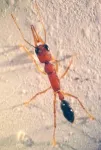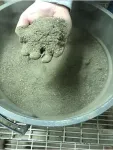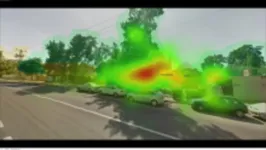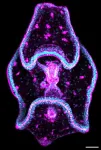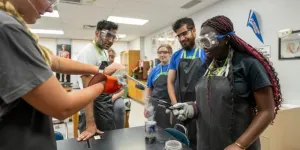Unlocking another piece of the Parkinson’s puzzle – scientists reveal workings of vital molecular switch
Scientists at the University of Dundee have uncovered the inner relay of a molecular switch that protects the brain against the development of Parkinson’s disease
2024-06-07
(Press-News.org)
Scientists at the University of Dundee have uncovered the inner relay of a molecular switch that protects the brain against the development of Parkinson’s disease.
The research provides new potential strategies to develop drugs that may benefit patients with Parkinson’s.
Parkinson’s is the fastest growing brain disorder in the world, however, there are currently no treatments that can slow or arrest the condition.
Previous research conducted at the University had found a gene called PINK1 is central to protecting brain cells against stress. In patients who carry PINK1 mutations, this protective effect is lost, leading to the degeneration of cells controlling movement that in turn lead to Parkinson’s symptoms.
PINK1 encodes a class of enzyme known as a kinase and acts as a sensor of damage to the ‘power generators’ of cells known as mitochondria. PINK1 then switches on a protective pathway by targeting two key proteins, ubiquitin and Parkin, that clears the damage. But how PINK1 was switched on was not previously known.
In research that has just been published in the journal Science Advances, a team of Dundee scientists, working with colleagues in the UK, Netherlands and Germany, used biological and artificial intelligence methods to uncover a model of the inner workings of how the PINK1 enzyme is switched on.
The model reveals how the PINK1 switch is activated by binding to key parts of a complex machine at the surface of mitochondria known as the Translocase of outer membrane (TOM) complex.
The new findings show that PINK1 uses unique elements not found in other enzymes. These make up a relay switch by which PINK1 is activated to enable it to target ubiquitin and Parkin to exert its protective function against Parkinson’s.
“As a clinician who treats Parkinson’s patients, the goal of our research is to discover fundamental mechanisms that may point to new ways to better treat the disease in the future,” said Professor Miratul Muqit, Consultant Neurologist at the Medical Research Council Protein Phosphorylation and Ubiquitylation Unit (MRC-PPU), in the School of Life Sciences at Dundee.
“Our new findings add to a number of emerging treatment strategies targeting the PINK1 pathway, some that are now entering clinical trials for Parkinson’s patients this year. This work provides a framework to undertake future studies directed at finding new drug-like molecules that can target PINK1 at the TOM complex.”
Professor Dario Alessi, Director of the MRC-PPU, added, “This is bold and painstaking molecular research which allows us to better understand the biology that underlies Parkinson’s disease, and provides new ideas on how PINK1-controlled Parkinson’s disease could be better diagnosed and treated, opening the door for further important research.”
The research was funded by the Wellcome Trust, Aligning Science Across Parkinson’s (ASAP), The Michael J. Fox Foundation for Parkinson’s Research (MJFF), and the Medical Research Council.
The study involved an international multi-centre collaboration with Professor Karim Labib at the University of Dundee; Professor Rubén Fernández Busnadiego at University Medical Center Göttingen / Cluster of Excellence “Multiscale Bioimaging: From Molecular Machines to Networks of Excitable Cells (MBExC)”; Professor Neil Ranson at the University of Leeds; and Dr Sebastian Mathea at Goethe-Universität, Frankfurt.
For more on Professor Muqit’s research see his profile here.
END
ELSE PRESS RELEASES FROM THIS DATE:
2024-06-07
While smell plays a considerable role in the social interactions of humans—for instance, signaling fear or generating closeness—for ants, it is vitally important. Researchers from New York University and the University of Florida found that a key protein named Orco, essential for the function of olfactory cells, is also critical for the cells’ survival in ants.
Their study showed that mutating the orco gene in Harpegnathos saltator jumping ants dramatically decreased the number of olfactory neurons, suggesting that Orco is necessary for the development and life of these cells. The findings, published in Science Advances, offer insights into the cellular ...
2024-06-07
ITHACA, N.Y. – Cornell University researchers have provided a simple and comprehensive – if less dramatic – explanation for bright radar reflections initially interpreted as liquid water beneath the ice cap on Mars’ south pole.
Their simulations show that small variations in layers of water ice – too subtle for ground-penetrating radar instruments to resolve – can cause constructive interference between radar waves. Such interference can produce reflections whose intensity and variability match observations to date – not only in the area proposed to be liquid water, but across the so-called south ...
2024-06-07
Toronto, ON, Canada - A new study conducted by researchers at the University of Toronto has unveiled a significant association between the use of photo filters on social media and increased symptoms of muscle dysmorphia among adolescents and young adults in Canada. This study, which analyzed data from 912 participants from the Canadian Study of Adolescent Health Behaviors, emphasizes the growing concern over the impact of digital image manipulation on body image and mental health.
The research reveals that the use of photo filters, commonly found on apps like Snapchat, Instagram, and TikTok, is linked to greater muscle dysmorphia symptomatology, a condition marked ...
2024-06-07
UNIVERSITY PARK, Pa. — Feed costs for producing broiler chickens accounts for 60% to 70% of total production costs, and stump waste from the production of button mushrooms comprises nearly 30% of total mushroom weight. Marrying the two has the potential to reduce both cost and waste, especially in Pennsylvania, which is a national leader in the production of broiler chickens and button mushrooms.
To learn whether the two are compatible, a team of Penn State researchers conducted a new study to determine how supplementing the feed of broilers with mushroom stump waste affected the growth and health of the chickens.
In findings ...
2024-06-07
New eye-tracking research has shown that simply looking at natural elements during urban walks can offer significant mental health benefits.
The study, by Bangor University and Technion- Israel Institute of Technology, published in the scientific journal People and Nature, involved city-dwellers, and showed how paying visual attention to greenery, rather than human-made structures, can alleviate anxiety and enhance restorative feelings.
The 117 urban residents who took part in the study, were guided on a 45-minute urban walk, while wearing eye-tracking ...
2024-06-07
By Devon McPhee
WOODS HOLE, Mass. -- Scientists have a handful of standard research organisms, including fruit flies and mice, that they use to study the evolutionary development (evo-devo) of animal lineages over time. Yet the more research organisms they can study, the deeper our understanding of life and the more knowledge we have to advance biomedicine and ecological conservation.
Researchers at the Marine Biological Laboratory (MBL), Woods Hole, and the Stazione Zoologica Anton Dohrn (SZS) in Naples, Italy, have added to the evo-devo toolbox by establishing Holothuria tubulosa, ...
2024-06-07
In the relentless fight against cancer, a new technology promises to shed light on how we track and understand the spread of this disease within the body. A research team from Northeastern University and Dartmouth College recently developed a remarkable tool called "diffuse in vivo flow cytometry" (DiFC), which allows for the noninvasive detection and counting of rare cancer cells circulating in the bloodstream.
Monitoring cancer spread in real time
In a recent publication in the Journal of Biomedical Optics (JBO), the research team detailed their innovative two-color DiFC system, capable of simultaneously detecting two distinct populations of cancer ...
2024-06-07
East Hanover, NJ – June 7, 2024 –May job numbers showed gains for people with disabilities, who continue to engage with the labor market at historic levels, according to today’s National Trends in Disability Employment – semi-monthly update (nTIDE), issued by Kessler Foundation and the University of New Hampshire’s Institute on Disability (UNH-IOD). Increases in both labor force participation and employment indicate that people with disabilities are not only striving to work but succeeding in finding jobs. ...
2024-06-07
ACM, the Association for Computing Machinery, has joined with the IEEE Computer Society (IEEE-CS) and the Association for the Advancement of Artificial Intelligence (AAAI) to develop “Computer Science Curricula 2023” (CS2023). CS2023 provides a comprehensive guide outlining the knowledge and competencies students should attain for degrees in computer science and related disciplines at the undergraduate level.
Establishing uniform curricular guidelines for computer science disciplines is viewed as being essential to the ongoing vitality of the field and the future success of the students ...
2024-06-07
Online education is effective for teaching complicated topics like quantum information science (QIS) to high school science educators, according to a new paper by University of Texas at Arlington researchers published in The Physics Teacher.
“COVID-19 forced educators to adjust their educational best practices to an unfamiliar virtual classroom, and professional development was no different,” said Karen Jo Matsler, assistant professor in practice for UTeach at UTA and lead author on the study.
Ramon Lopez, professor of physics, was coprincipal investigator ...
LAST 30 PRESS RELEASES:
[Press-News.org] Unlocking another piece of the Parkinson’s puzzle – scientists reveal workings of vital molecular switch
Scientists at the University of Dundee have uncovered the inner relay of a molecular switch that protects the brain against the development of Parkinson’s disease
